Rose Blue Moon
Blue Moon, Cl. - a variety of climbing tea-hybrid rose. Sport grade ‘Mainzer Fastnacht'(Blue Moon). Introduced by Julie Jackson in Australia in 1978, in the USA in 1981 by Fred A. Mungia.
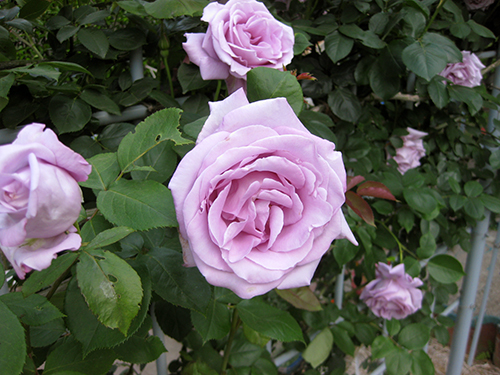
The plant is vigorous, spreading, reaches a height of 220 - 300 cm (in warm regions it can grow up to 400 cm), in width - up to 75 cm. The shoots are curly, long and strong, practically without thorns. Leaves are matte, green in color.
The flowers are large, 10-11 cm in diameter, and contain about 25 petals. They have a lilac color. In the sun, they acquire a bluish tint, in the shade - crimson. Unopened purple bud. The shape of roses changes during flowering from a conical bud to a goblet. The aroma of flowers is pleasant, intense, with light notes of citrus and rose oil, which lasts throughout the season.
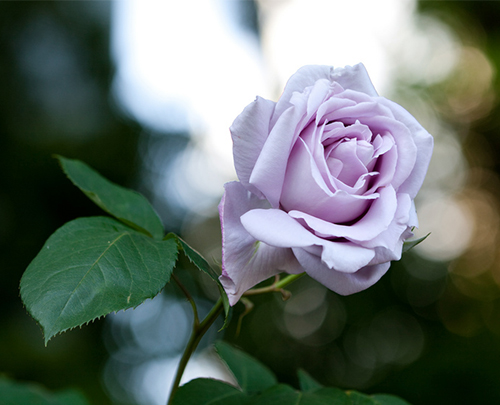
Long bloom, from June to autumn. Cutting off the shoots after flowering is not required, just shorten it by 10 - 15 cm.
Blue Moon, like any climbing rose, does not like the north wind, close planting, lowland and swampy places. Prefers fertile, loose soil with good drainage. It grows best in warm climates, since in such conditions it quickly builds up a branchy structure, due to which it blooms more abundantly, especially with timely feeding and prevention of diseases.
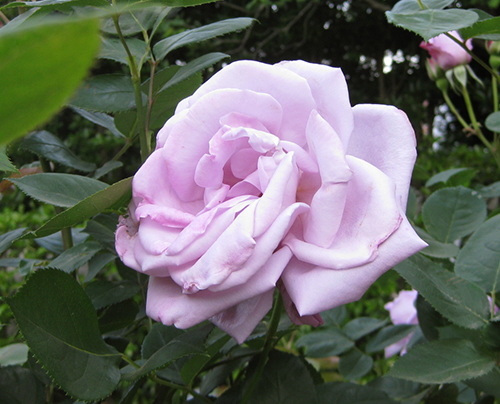
With pruning, Blue Moon can be grown as a bush or as a climbing rose with shoots up to 4 meters long. In this case, the plant must be tied to the supports. It is better to prune the shoots of climbing roses before they are lignified, and it is also advisable to replace pruning of herbaceous shoots with plucking. It is undesirable to transplant this climbing rose after the second year of growth, since the root system grows very powerful.
USDA frost resistance: zone 6 (minus 17 - 20 ° C). Resistance to powdery mildew and black spot is average.
Advantages: abundant flowering, unusual color and pleasant aroma of flowers.

The main disadvantage is poor resistance to diseases and bad weather conditions.
Blue Moon, Cl. - an unusually fragrant and sophisticated rose. Perfectly decorate open terraces, gazebos and fences. Also, thanks to the curly shoots, it is ideal for creating flower arches, vertical landscaping, for growing on trellises and pergolas. Combines beautifully with cream or lilac shades, such as ‘Blue Parfum’, ‘Moody Blue’, ‘Eyes for you',' Novalis ',' Rokoko ',' Marie Antoinette 'and'Rhapsody in blue'. You can also emphasize the delicate color with lighter shades of ‘Avalanche’ and ‘Pascali’ flowers. You can contrast this variety with 'Berleburg' and 'Rhapsody in Blue' roses, complementing the composition with lavender (Lavandula angustifolia), sage (Salvia officinalis), bellflower (Campanula carpatica) and gypsophila (Gypsophila). These fantastic compositions will be a charming and sophisticated decoration for your garden.
Synonymous names: 'Blue Monday, Cl.', 'Blue girl, Cl.', 'Mainzer Fastnacht, Cl.', 'Sissi, Cl.'.


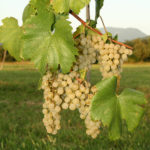
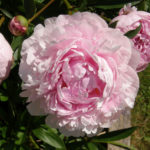





First, a hybrid tea variety of this variety appeared in my garden. Then I found out that there is the same climbing soft lilac charm. I planted it immediately in a sunny place on the south side of the house so that the flowers do not lose their bluish tint. By the way, in comparison with my hybrid tea bush, the climbing Blue Moon flowers were not so bright. They were lighter in color, with a kind of silvery satin sheen. Against the background of dark green shiny leaves, this is just space! The planting was in spring, and in the first season my rose stretched out the whips by 2 meters, but did not open a single bud. But the next year it bloomed all summer until autumn, and spread the lashes 5 meters long.